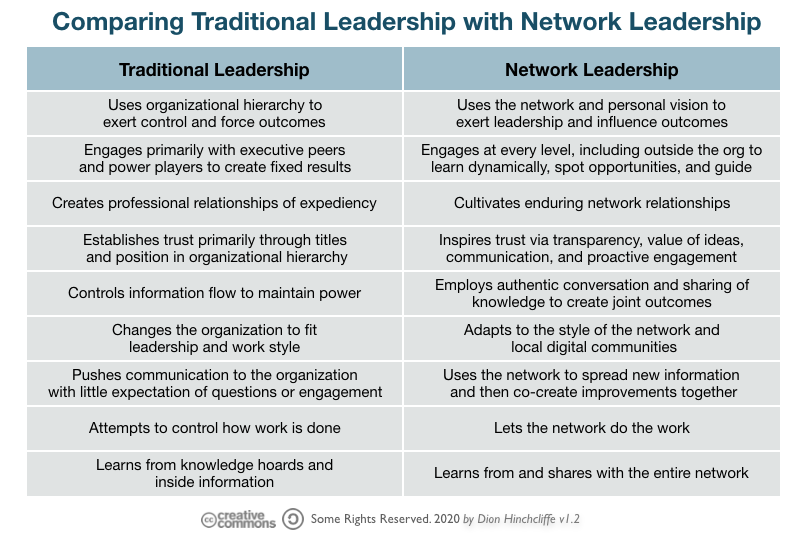
It is a remarkable time in this particular moment in human history, where most organizations have become almost entirely distributed, yet for the first time still remain largely functional. We can thank a combination of three modern advances for this, which have never been available to us before at their current level of maturity. Namely, ubiquitous computing devices in most people’s homes, along with pervasive Internet access across the developed world, and a truly remarkable host of new enabling tech-based tools, from online video conferences and team chat to shared digital whiteboards and work coordination tools, even entire virtual worlds.
While it may not feel like it to most of us, we actually live in a time that is much less impacted by a pandemic, at least by these measures. It is the countless recent innovations of modern technology that have created a new respite for us and our organizations, and one that we can use to minimize disruption as well as prepare for our new future. Yet the shift to work from home (WFH) or remote work, as it is often called, does come at a significant cost. The loss of real human connection is one. The replacement of in-person contact by the hermetically sealed faces of our co-workers on video conference grids does distance ourselves from them in surprising ways when we have to do it week after week. But these inconveniences are in the end, mostly manageable.
How To Lead an Entire Organization Through a WiFi Connection
Instead, perhaps the most significant shortfall in becoming virtual organizations is that we haven’t acquired or developed leadership skills that work well in these powerful new digital venues. Being a leader, which is defined as someone who helps motivate groups of people towards useful goals, is often conducted quite differently via a shared technological medium. In fact, as we’ll see, the digital version of taking the helm of a team, department, or enterprise, known as network leadership, is currently in woefully short supply. Now is the time to change that.

While there are a number of essential skills that help organizations create useful business outcomes with distributed teams through the use of the most modern digital tools, here I’ll assume the most scalable kind — enterprise social networks or online communities — I find that leadership is almost always at the top of the list of challenges in using them well. In fact, the leaders themselves have, until now, often been the ones least engaged in them.
With today’s global lockdown orders, there is now no avoiding that what executives and middle managers actually do when it comes to leadership with digital networks has a inordinate impact on whether workers will a) usefully employ digital tools in their day-to-day work, b) take unique advantage of what makes the newer tools so potent, and c) actually deliver the impactful results needed to sustain the organization in a more digital form.
I’ve studied or helped organizations apply the key success factors of digital collaboration for years, and there remains a key question that seems to come up as frequently as ever:
What exactly should leaders do to enable their organizations and themselves to adopt the most effective concepts and work techniques of digital networks to the way they work?
The good news is that it turns out that enablement of the overall underlying methods of digital-style leadership by corporate leaders actually requires some of the same key skills that made them top managers in the first place: Effective communication, the ability to get others to follow their lead, the ability to formulate a vision and inspire others with it, getting things done, and perhaps most of all, the ability to encourage others to help carry out positive changes to move into the future.
Leadership today also requires a set of attributes that many managers usually do not yet have today: Knowledge of and skills with modern digital collaboration tools, and their techniques and strategies. As my industry colleague Cerys Hersey once noted, contemporary platforms like the enterprise social network are becoming our corporate ‘operating system’, at least in a significant — and steadily growing — percentage of large organizations today according to the latest market research as of 2019.
The full and compelling motivations for using a social network as a foundation for — and a digital analogue of — how a modern corporation operates is a rich topic that I explored in my book on the topic, Social Business by Design. However, you can consult a brief primer here, and the short version is that it enables truly engaging employees, helping them work together in innovative new ways, tapping deeply into their knowledge to enable widespread learning, scaling work processes in new and potent ways, creating richer/better institutional practices, and capturing a highly differentiating corporate body of knowledge, among other known benefits.
So, of all the new skills that executives have to learn today, perhaps the most important is network leadership, which the well-respected Executive Board urgently identified a few years ago in their report, The Rise of the Network Leader, as a major new evolution in management skills, which can contribute up to twice the profit growth in organizations which have the most effective leaders:
Analyzing the relative performance of more than 3,000 leaders, CEB has found that organizations with the strongest leaders in changing times have double the rates of revenue and profit growth compared to those with weaker leaders.
Unfortunately, many organizations and their leaders struggle to meet these mounting demands; those who struggle are hard pressed to maintain their advantage as the work environment changes and the nature of leadership in the new work environment shifts. CEB research shows that many leaders are poorly equipped to thrive in the new, rapidly changing digital work environment.
Digital Networks: The New Management Imperative
The lesson here is that it’s now urgent for executives and managers to acquire network leadership skills in order to succeed in today’s pandemically-induced remote work environments, rife as they are with many new types of digital collaboration environments that can help them wield outsize leadership influence. They can and should use this broad digital grasp to bring everyone together into a healthy enterprise-wide online community as well as orchestrate high-scale adaptations and performance improvements for their organizations. Beyond the usual corporate focus on revenue and profit, which network leadership can readily deliver in potent and innovative new ways, network leadership also fosters a fundamentally better, high performing, more aligned, and more satisfying workplace for everyone.
As Altimeter’s Charlene Li, in her examination of how digital is remaking the styles, techniques, and even the very culture of leadership, singled out in her best-selling new book The Engaged Leader, notes that:
In order to be truly effective today, leaders in business and society must change how they engage, and in particular how they establish and maintain relationships with their followers in digital channels.
The good news is that top corporate executives are realizing the imperative of leading through digital channels. There are now leading examples of network leaders from highly respected organizations around the world, including business luminaries such as Richard Branson, Rupert Murdoch, Mary Barra, Marc Benioff, Marissa Mayer, and even Harvard’s Bill George, though there are certainly still considerable differences in digital engagement depending on corporate responsibility.
So, to understand exactly what top network leaders do in today’s digital networks, let’s examine the patterns that have emerged in what leaders do, day-by-day, to cultivate and exert effective network leadership within their organizations and outside of them.
Create Reach: Cultivate Network Capital
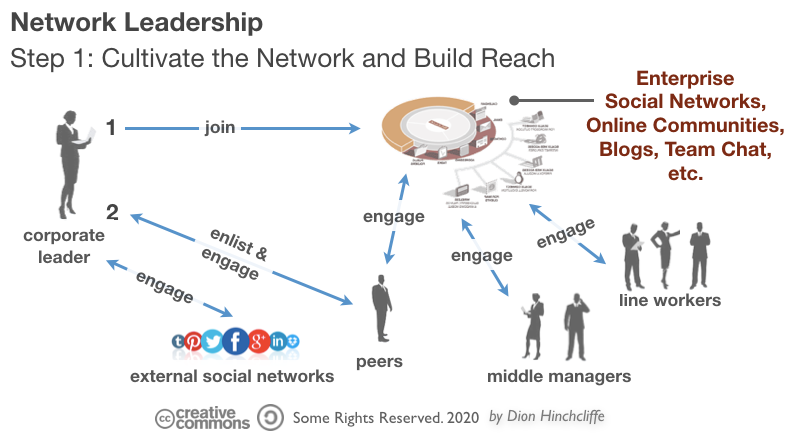 Getting an organization to engage with an executive over an enterprise social network can be straightforward if you’re a well-known and/or well-liked leader. But most executives will have to work fairly diligently on building a network of followers in the organization. Over time, these individuals will pay a growing amount of attention to them communication and value steadily flows from the executive through their daily activities. And that’s just internal cultivation of network capital. It can be much more work to gain a relevant network following on the other major arena: Out on the Internet. In its simplest form this is gaining followers interested in your industry work on popular social networks. More meaningfully, it becomes the entire set of online conversations, group activities, and concrete value streams that have your professional social identity connected to them in some way. Fortunately, there are plenty of resources that can teach executives the necessary skills. In particular, reverse mentoring programs such as at Bayer Material Sciences have been known to be particularly effective at helping executives rapidly acquire the necessary skills.
Getting an organization to engage with an executive over an enterprise social network can be straightforward if you’re a well-known and/or well-liked leader. But most executives will have to work fairly diligently on building a network of followers in the organization. Over time, these individuals will pay a growing amount of attention to them communication and value steadily flows from the executive through their daily activities. And that’s just internal cultivation of network capital. It can be much more work to gain a relevant network following on the other major arena: Out on the Internet. In its simplest form this is gaining followers interested in your industry work on popular social networks. More meaningfully, it becomes the entire set of online conversations, group activities, and concrete value streams that have your professional social identity connected to them in some way. Fortunately, there are plenty of resources that can teach executives the necessary skills. In particular, reverse mentoring programs such as at Bayer Material Sciences have been known to be particularly effective at helping executives rapidly acquire the necessary skills.
Be Transparent and Communicative: Working Out Loud
 Digital networks only become truly powerful business tools when executives start to set their knowledge free to work out in the network on a routine day-to-day basis. Leaders must also build authentic and meaningful conversations with other stakeholders on the network, and so the currency of lightly narrating your work activities on social channels, including what you’re doing and what issues you are facing is considered a key network leadership technique. Cultivating these digital habits will have the benefits of automatically creating more transparency and a shared understanding of what the organization is actually facing at an executive level. Working Out Loud can also directly improve employee engagement, which can be low particularly because meaningful ongoing storytelling is often missing in large organizations, despite inclusive corporate cultures being widely regarded as drivers of high performance. This narration process, which can be usually be accomplished in the margins of executive schedules, also becomes the basis for building even more social capital, as well as enlisting the organization to help just-in-time with key issues, as innovative ideas and solutions often have a strange way of coming from where you least expect it. You can learn more about Working Out Out from my friend and collaboration industry colleague John Stepper, who has long promulgated it.
Digital networks only become truly powerful business tools when executives start to set their knowledge free to work out in the network on a routine day-to-day basis. Leaders must also build authentic and meaningful conversations with other stakeholders on the network, and so the currency of lightly narrating your work activities on social channels, including what you’re doing and what issues you are facing is considered a key network leadership technique. Cultivating these digital habits will have the benefits of automatically creating more transparency and a shared understanding of what the organization is actually facing at an executive level. Working Out Loud can also directly improve employee engagement, which can be low particularly because meaningful ongoing storytelling is often missing in large organizations, despite inclusive corporate cultures being widely regarded as drivers of high performance. This narration process, which can be usually be accomplished in the margins of executive schedules, also becomes the basis for building even more social capital, as well as enlisting the organization to help just-in-time with key issues, as innovative ideas and solutions often have a strange way of coming from where you least expect it. You can learn more about Working Out Out from my friend and collaboration industry colleague John Stepper, who has long promulgated it.
Engage on the Network Regularly: Stay Involved at Multiple Levels, Channels
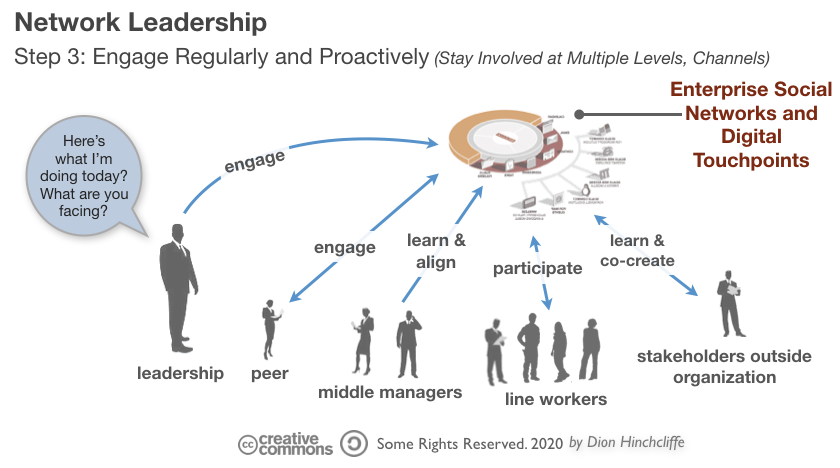 As one might suspect, just narrating your own work is not sufficient to be a network leader. One must also track key conversations and work streams happening within your networks and social followings. While there’s no way to keep track everything that’s happening, most enterprise social networks have volume controls and filters to let you focus on what matters to you at the time, such as what particular teams, projects, or even people are doing, while still making sure enough serendipity still occurs. It’s important to stay involved at a sustainable pace at multiple levels in the organization across the key digital/social channels, as it’s long been understood that diversity of information and stakeholders creates the most vibrant and useful knowledge networks, never mind that remote work creates higher barrier to visibility across the virtual organization. Opportunities for doing more within network, as well as learning about the organization — and perhaps most of all about your customers — faster than ever before, soon become obvious.
As one might suspect, just narrating your own work is not sufficient to be a network leader. One must also track key conversations and work streams happening within your networks and social followings. While there’s no way to keep track everything that’s happening, most enterprise social networks have volume controls and filters to let you focus on what matters to you at the time, such as what particular teams, projects, or even people are doing, while still making sure enough serendipity still occurs. It’s important to stay involved at a sustainable pace at multiple levels in the organization across the key digital/social channels, as it’s long been understood that diversity of information and stakeholders creates the most vibrant and useful knowledge networks, never mind that remote work creates higher barrier to visibility across the virtual organization. Opportunities for doing more within network, as well as learning about the organization — and perhaps most of all about your customers — faster than ever before, soon become obvious.
Related: What IT Leaders Should Prepare for Post-Pandemic
Work Through the Network: Orchestrate and Co-Create
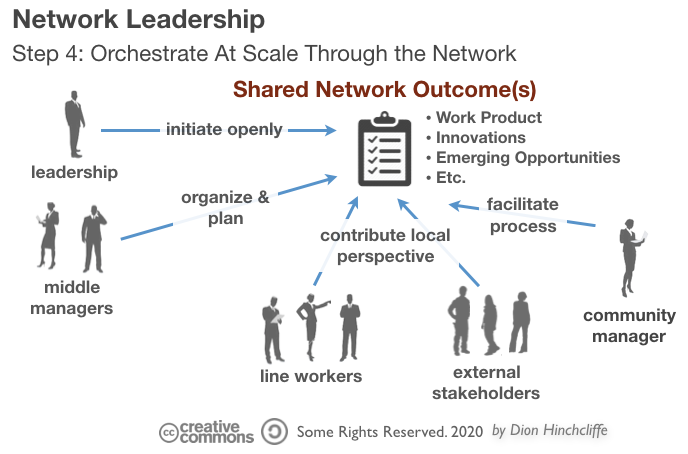 Once a leader has sufficient network capital, along with involvement and credibility within various digital networks and communities, they can begin to more actively wield their influence and leadership strategically over the network. What’s more, this engagement can scale far higher — and much faster — than traditional relationship networks, which is one of the key benefits of digital/social.
Once a leader has sufficient network capital, along with involvement and credibility within various digital networks and communities, they can begin to more actively wield their influence and leadership strategically over the network. What’s more, this engagement can scale far higher — and much faster — than traditional relationship networks, which is one of the key benefits of digital/social.
Leaders can also use networks to proactively enlist participative stakeholders in driving successful change and co-creation, seizing business objectives, solving vital problems, and harvesting needed innovation, or even just getting vital work done. Executives can maintain corporate alignment across a highly diverse workforce, while directing the co-creation of solutions to the issues of the day. What’s fascinating is that these activities don’t tend to put much of an additional burden on the workforce because of two sources of headroom: Many employees aren’t fully engaged until their leaders work more closely with them, and most organizations still have a significant cognitive surplus. So while network leadership is fundamentally about moving towards improved engagement with your stakeholders, it also has transactional benefits as well. Finally, if you’re still not sure about all this, the Collaborative Leaders Network has many compelling example of executives using collaboration and co-creation — particularly over networks — that led to better outcomes.
Use the Network to Learn, Then Optimize
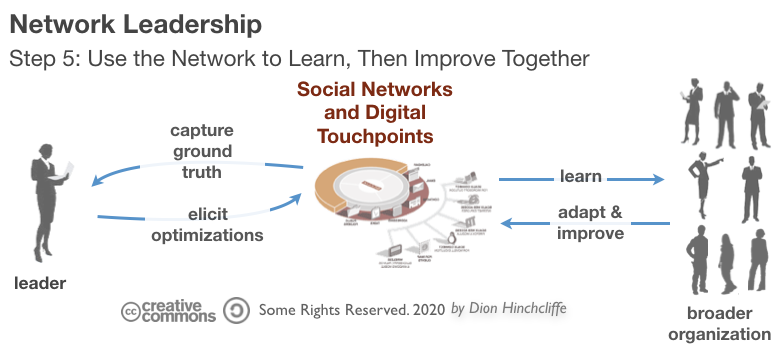 As I’ve pointed out in exploring how our organizations are heading towards a 4th Platform, networks are also the ideal place to learn, and from the learning to improve ourselves and our organizations. Enterprise social networks are therefore terrific environments to learn in the large, because most of the activity is out in the open and can therefore be analyzed for a variety of strategic business objectives. Leaders can also use their digital networks for informal and unstructured learning, and getting ‘ground truth’ about what’s really going on and how things are actually accomplished within their organizations.
As I’ve pointed out in exploring how our organizations are heading towards a 4th Platform, networks are also the ideal place to learn, and from the learning to improve ourselves and our organizations. Enterprise social networks are therefore terrific environments to learn in the large, because most of the activity is out in the open and can therefore be analyzed for a variety of strategic business objectives. Leaders can also use their digital networks for informal and unstructured learning, and getting ‘ground truth’ about what’s really going on and how things are actually accomplished within their organizations.
Network Leadership: How To Get Started, and What’s Needed
Fortunately, since nearly two-thirds of organizations now have the necessary networks internally, and 100% have the needed external networks (social media), almost everyone can get started on network leadership these days.
Note, however, that one key concept that is depicted in the visuals for each step above is the capability of community management, an essential function to maximize the operational results of digital networks. Community managers can also make the process of leaders getting involved and developing the skills, and even working through high value scenarios, far easier than it would be otherwise. Chances are good that your organization has people that already do this, but if not, they can be found online with only a bit of effort, such as contacting the excellent Community Roundtable.
Lastly, this is a new journey and new management skill that we are all learning together as business evolves into more organically networked structures. There is little doubt in the value of network leadership, but the rule of thumb tends to be the more that you put into it, the more you and your organization will get out of it.
Ultimately, I believe that the real question that leaders must ask themselves now is this:
What will I do with this unprecedented new strategic management capability in these unprecedented times?
Note: This is a substantially revised update of a previous exploration I made of network leadership. I’ve updated it as appropriate for our current situation in mid-2020.
Additional Reading:
How Work Will Evolve in a Digital Post-Pandemic Society
Revisiting How to Cultivate Connected Organizations in an Age of Coronavirus
My 2020 Predictions for the Future of Work


